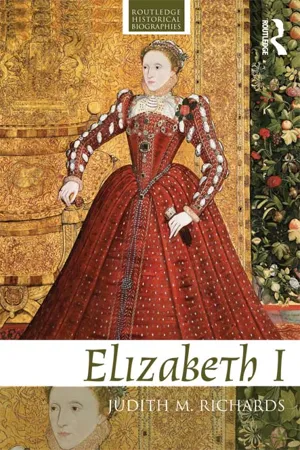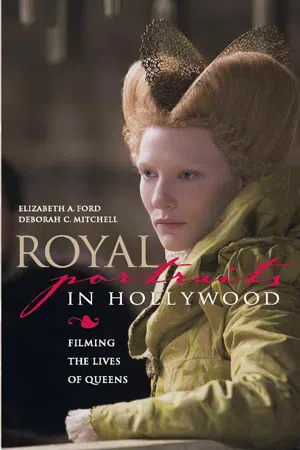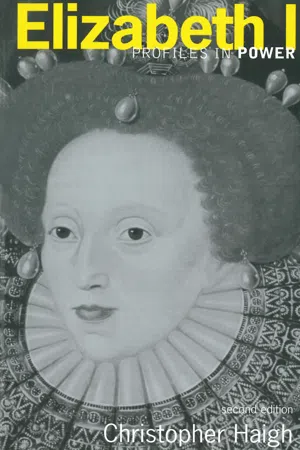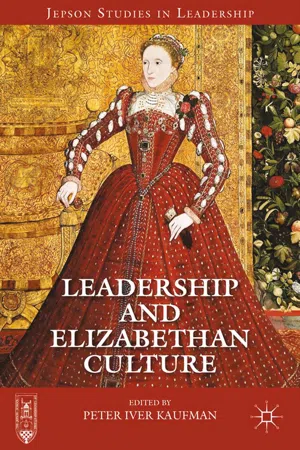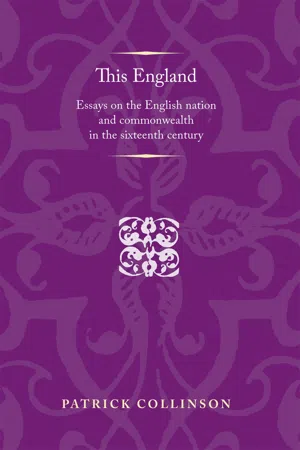History
Queen Elizabeth I
Queen Elizabeth I was the last monarch of the Tudor dynasty and ruled England from 1558 to 1603. She is known for her strong leadership, successful navigation of religious tensions, and the defeat of the Spanish Armada. Elizabeth's reign is often referred to as the Elizabethan era, a time of cultural flourishing and expansion of English influence.
Written by Perlego with AI-assistance
Related key terms
6 Key excerpts on "Queen Elizabeth I"
- eBook - ePub
- Judith M. Richards(Author)
- 2013(Publication Date)
- Routledge(Publisher)
10
What can be known ofElizabeth I?
Promoting or knowing Elizabeth?
As has been suggested several times in this study, many of the surviving sources for the reign of Elizabeth are imperfect, although she is by no means the only monarch for whom 16th and 17th century sources are often dubious. Indeed, royal biographies in the early modern era have more generally been described as belonging ‘inthe inter sections of chronicle, politic history, panegyric, martyrology, hagiography, confessional polemic and … ballads, poems, sermons, pageants, and plays’.1 That was indeed true in the case for Elizabeth Tudor, and identifying the actual Elizabeth within the propaganda that shaped her multiple representations remains a significant problem. Indeed, those polemics began even before she took the throne, at a time when her both personality and her abilities were hardly known beyond immediate court circles. As the only plausible Protestant counter to the triumphant Marian resurgence of Catholicism and as the legal heir to Mary, it was inevitable that she was widely praised and pronoetd by Protestant hopefuls.If the outpourings of praise and advice for Elizabeth were more plentiful than for other monarchs, one reason was that for so many of her subjects she remained a problematic monarch. Consequently her more supportive subjects competed to praise her ever more elaborately, not only to demonstrate their loyalty but also to persuade her to endorse their preferred judgements. Some of her doctrinal caution, a recurrent irritant to more zealous Protestants, was undoubtedly because, after Mary died in 1558, Elizabeth understood rather better than many of her advisers that she had inherited a predominantly Catholic realm. - eBook - ePub
Royal Portraits in Hollywood
Filming the Lives of Queens
- Elizabeth A. Ford, Deborah C. Mitchell(Authors)
- 2009(Publication Date)
- The University Press of Kentucky(Publisher)
Chapter SevenQueen Elizabeth I
I will have but one mistress and no master. —Elizabeth IImages of the Virgin Queen fast-forward across film history, unforgettable, iconic images: the stately bearing; the red wigs; the high forehead; the long, aristocratic nose; the alabaster makeup; the pearl-drop earrings; the stiff, ornate ruffs; the fingers dripping with jewels; and the gowns, with yards and yards of white satin, purple velvet, gold, and silver ornamented and sparkling with rubies, diamonds, and more pearls. Even a schoolchild would be hard-pressed to mistake her for any other monarch.As a case in point, this past fall, on one of our many visits to the National Portrait Gallery in London, we were strolling through the Tudor Rooms, contemplating the familiar faces of Elizabeth I and her entourage—Henry VII, Henry VIII, Mary Tudor, Robert Dudley, Francis Walsingham, William Cecil, Christopher Hatton, Sir Walter Raleigh, Sir Francis Drake, Robert Devereux, and others—when we happened on a primary school teacher and her class. The children, maybe seven or eight years old, all dressed neatly in their navy blue school uniforms, were sitting cross-legged on the floor in front of Elizabeth I’s coronation portrait. The teacher asked: “Now, who is this?” Twenty hands shot into the air. “Queen Elizabeth the First,” one child confidently answered. “Who was queen before Elizabeth?” Tiny voices in unison responded: “Her sister, Mary.” And so it went as the teacher took the children through a visual history lesson, moving from portrait to portrait of the Virgin Queen, her kindred, her courtiers, and her counselors. Their answers came swiftly, with a kind of assurance that only the very familiar breeds. How many times in their short lifetimes had they seen the imprint of that famous face? we wondered. Mesmerized, we followed the group until at last, two by two, in a quiet, orderly queue, they left the gallery, images of Gloriana sealed forever in their minds.Queen Elizabeth I. (Courtesy Victoria and Albert Museum, London/Art Resource, New York.) - eBook - ePub
- Alison Plowden(Author)
- 2011(Publication Date)
- The History Press(Publisher)
CHAPTER ONEA wise and religious Queen
‘We have a wise and religious Queen’ John Jewel, London, 22 May 1559W HEN Elizabeth Tudor succeeded to her sister’s throne in November 1558 she was the same age as Mary Stuart at the time of her flight into England, but Elizabeth at twenty-five was still very much of an unknown quantity. This was partly due to the fact that she had spent most of the previous five years either in prison or living in rural retirement under some form of surveillance, and partly to the habits of discretion and dissimulation acquired during her precarious adolescence, However, as it became obvious that the ailing, unhappy Mary Tudor would leave no other heir, international curiosity about the young Elizabeth had intensified, and in 1557 the Venetian ambassador included a detailed description of the Princess in his report on his tour of duty in England. Her face, wrote Giovanni Michiel, was comely rather than handsome, but she was tall, well-formed and with a good skin, although sallow. She had fine eyes and very beautiful hands which she took care to display.Even in her early twenties, the pale, sharp-featured, red-haired Elizabeth had never been able to compete with her Scottish cousin’s fabled beauty, but she possessed other attributes which were to prove of greater value in the long-drawn-out battle between them. As early as 1557, Michiel could comment respectfully on the excellence of her mind and on the wonderful intellect and understanding she had shown when facing danger and suspicion. She was proud, too, and haughty, he declared, in spite of the fact that her birth was regarded as illegitimate by most of Christian Europe and that her mother, the great-granddaughter of a London mercer, had once been commonly referred to as that goggle-eyed whore Nan Bullen. Nevertheless, Elizabeth it seemed did not regard herself as being of inferior degree to her half-sister the Queen, whose mother had been a Spanish princess of irreproachable lineage and virtue. ‘She prides herself on her father and glories in him’, wrote Michiel, adding that her resemblance to Henry VIII was remarked by everybody. - For, although it suited her to exaggerate the extent, Elizabeth’s really was a new regime. Under the pretence that Mary’s Privy Council had been too large and factious, Elizabeth dismissed two-thirds of its members and replaced them with her own relations, servants, and political allies – led by William Cecil, Nicholas Bacon, and Thomas Parry. In the royal Household, in the Court, the change-over was even more marked: Elizabeth surrounded herself with those she knew she could trust, her late mother’s relatives and her own domestic staff. Robert Dudley and his brother Ambrose, sons of the late Duke of Northumberland, provided the necessary muscle, with the Dudley military clientele remaining intact. The Queen had created a rather narrowly based government, defined by personal loyalty to herself and ideological loyalty to Protestantism – for in dismissing the Marians she had dismissed most of the Catholics, and in reappointing some of Edward VI’s ministers she had recruited Protestants. But the novelty and homogeneity of the regime should not be overemphasised: Elizabeth’s ‘new men’ were mainly experienced administrators from Edward’s era, and the realities of political power had forced her to retain some conservative councillors. Some of the less partisan of Mary’s bureaucrats – Winchester, Mason, and Petre – stayed in office, and, more importantly, so did the great regional magnates, the Earls of Derby, Shrewsbury, Pembroke, and Arundel. It was a government which typified Elizabeth’s approach to politics: under the banner of novelty she assembled an alliance of experienced men, and behind the public face of Protestantism she made the necessary compromise with conservatism. The rhetoric of monarchy was one thing: the politics of power was quite another.But the continuities in power were masked by the rhetoric of reform, and the public image was one of sparkling novelty. Elizabeth sought support by discrediting her predecessor’s rule and dissociating herself from it. The problems of the realm were determinedly blamed upon the previous government, and its reliance upon Catholicism and Spain; a change of ruler would bring solutions. Elizabeth had to differentiate her regime from Mary’s because they had something very obvious in common: they were both women, and some men had related the difficulties of Mary’s reign to her sex. Thomas Becon had cried to God in 1554, ‘Thou hast set to rule over us a woman, whom nature hath formed to be in subjection unto man, and whom thou by thine holy apostle commandest to keep silence and not to speak in the congregation. Ah, Lord! to take away the empire from a man, and to give it to a woman, seemeth to be an evident token of thine anger toward us Englishmen.’ Becon then republished his words in 1564, with no indication that a Protestant queen was any better than a Catholic, or that Elizabeth was any less of a punishment than Mary had been. Rule by a woman was the antithesis of proper order, and was bound to lead to disaster. ‘Queens were for the most part wicked, ungodly, superstitious and given to idolatry and to all filthy abominations’, wrote Becon, picking out Jezebel, Athalia, and Herodias as typical examples.2Elizabeth, like Mary before her, had an image problem – what was the appropriate image of a female ruler? In sermons and prescriptive literature, sixteenth-century Englishmen propounded an ideal of womanhood, and it was an ideal which left little room for an unmarried female ruler: a woman should be a wife, and she should be silent, obedient, and domestic. A woman might rule her own kitchen, but surely not her own kingdom; outside the kitchen, she should be under the authority of a man, because she was physically, intellectually, and emotionally inferior to men. A woman’s role was essentially passive and subservient; throughout Elizabeth’s reign, the preachers continued to insist that it was contrary to nature for a woman to exercise authority over men in a family. If a woman could not rule a household, how could Elizabeth rule a realm? John Aylmer argued in 1559 that if she married, Elizabeth the woman could not be head of her own family, but Elizabeth the queen could head the realm. Still, there was a male Council and a male Parliament to run things, so ‘it is not in England so dangerous a matter to have a woman ruler as men take it to be’.3
- eBook - ePub
- P. Kaufman, P. Kaufman(Authors)
- 2013(Publication Date)
- Palgrave Macmillan(Publisher)
C H A P T E R O N E Queen Elizabeth I of England: Monarchical Leadership in ActionSUSAN DORANAnd as I am but one body naturally considered, though by His permission a body politic to govern, so I shall desire you all, my lords (chiefly you of the nobility, everyone in his degree and power) to be assistant to me, that I with my ruling and you with your service may make a good account to almighty God and leave some comfort to our posterity in earth. I mean to direct all my actions by good advice and counsel.1In this—her first speech as Queen on November 20, 1558—Elizabeth I set out her stall as a political leader. In case questions were asked about her right to govern (on grounds of her gender or bastard status in law), the new Queen declared unequivocally that she was God’s chosen ruler; and since her legitimacy was based firmly on divine right (and not on election or statute), her authority could not be questioned or her power challenged. At the same time, using the metaphor of the body politic, Elizabeth saw herself as the chosen head of a hierarchically organized state; and, of course, if the limbs did not follow the head, chaos would follow. But, as the speech also made clear, Elizabeth declared her readiness to listen to advice. She would share the responsibilities of government with her foremost men by heeding counsel and directing her actions accordingly. Although in reality it was always impossible for a ruler to govern alone, Elizabeth emphasized that it was her personal choice—and not necessity—that dictated her decision to seek counsel; and she did so for the good of the commonwealth and the “good comfort” of her subjects.In this speech Elizabeth was shaping herself as a model prince and the antithesis of a tyrant. At one level, there was nothing very novel in her assertions. The divine right of kings was barely questioned in the sixteenth century, while listening to good counsel and ruling in the interests of the commonwealth had been accepted as a mark of good kingship for well over a century and was emphasized in widely read humanist texts such as Sir Thomas Elyot’s The Book Named the Governor .2 Nonetheless, tensions were to arise between Elizabeth and many of her leading subjects when the functions of counsel were considered.3 - eBook - ePub
This England
Essays on the English nation and Commonwealth in the sixteenth century
- Patrick Collinson(Author)
- 2013(Publication Date)
- Manchester University Press(Publisher)
Neale used to say ‘there are no pundits in history’, although Hurstfield suspected that he made an exception of himself. The 1590s were very different. John Guy has called them the second reign of Elizabeth, anticipating in many ways the early Stuart monarchy. 95 We need to go on discussing why that should have been so. The history of gender is now unavoidable, although it may be noticed that I have so far tried my level best to steer around it. There have been three or four books in the recent past on the implications of John Knox’s argument that female government (the ‘regiment’ of women) was unnatural government, and of the various responses to Knox. 96 We shall not necessarily agree on how important it was that Elizabeth was a woman, whether in all the circumstances there would have been a crisis, not so much of authority as of the directions to be taken by authority, even if she had been a gay man equally disinclined to marry, and to breed. Watch this space. How far does all this add up to an adverse verdict on Elizabeth I and her supposedly glorious rule? You may think that it must. Or, alternatively, you may conclude that for Elizabeth to have held her corner in these circumstances, to have become anything but a monarchical cipher, adds to our sense of her greatness; and that she was quite right, on all sorts of grounds, to have resisted the pressure to embrace more adventurous, expensive and risky policies. Biographers like Paul Johnson have praised her above all for her courageous conservatism, have made that their main theme. 97 But it is happenstance rather than policy which determines the course and outcome of a history like hers. Elizabeth gambled on the unlikely chance of living to the age that she did, outliving the problems which loomed so large in the 1570s and 1580s. The odds were long, and the stake was the very survival of England as a Protestant nation
Index pages curate the most relevant extracts from our library of academic textbooks. They’ve been created using an in-house natural language model (NLM), each adding context and meaning to key research topics.
